This thread started out here http://www.diyaudio.com/forums/full-range/268626-vifa-tc9fd18-08-best-bang-buck-12.html#post4229714 , but I thought it should be broken off as its own thread since it covers more than just the TC9FD driver. I also wanted it be an easily accessible source of information for those getting started in full range drivers looking for data on relative performance between the many different brands and models. Even within the same brand and model, there are often variants for paper vs metal cones.
My approach was originally to use an IEC Standard 268-5 Baffle for drivers under 8 inches. It turns out that a baffle size of 1350 mm x 1650 mm (h, v) is huge (larger than any single piece of plywood you can buy) and not very practical for home use. I think that most diy'ers, even those going with an open baffle route will not utilize something quite this large.
So my approach was to have a moderate practical baffle, but one that minimizes baffle edge diffraction effects, and I wanted to contain the rear wave in a semi-infinite baffle type chamber - almost like cutting a hole in a wall and letting the adjacent room serve as the back chamber. One of my earlier designs has a performance and behavior very close to this but is compact. The Nautaloss is a sealed tapered spiral TL, more info here: http://www.diyaudio.com/forums/full-range/247598-nautaloss-ref-monitor.html. To the Nautaloss, I will fit a supra-baffle that is trapezoidal in shape with the driver offset from the center. This prevents any two distances from the driver to the edge being identical to minimize baffle edge diffraction/interference effects from causing rippling in the response.
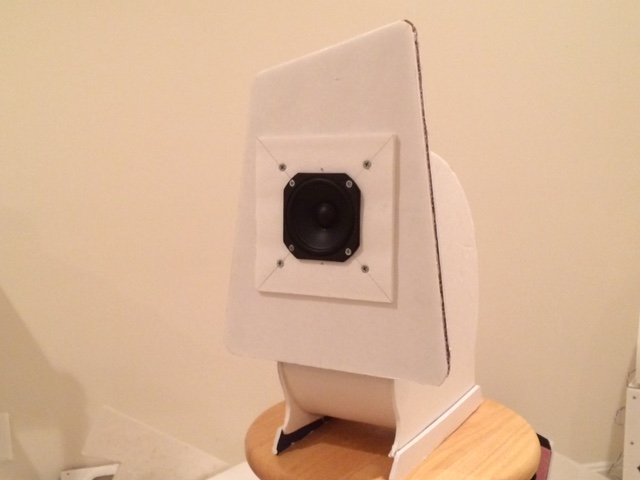
Dimensions of trapezoidal supra-baffle (edge lengths): top=7.0in, bottom=12.0in, left=11.25in, right=13.0in. Driver centerline is 5.0in from left bottom corner and 6.0in up from bottom edge.
Here is the measurement in a trapezoidal supra-baffle mounted on the Nautaloss with a TC9FD. The measurement is near field with mic at 12.7cm away. I think the design seems to provide a very smooth response in the near-field.
TC9FD:
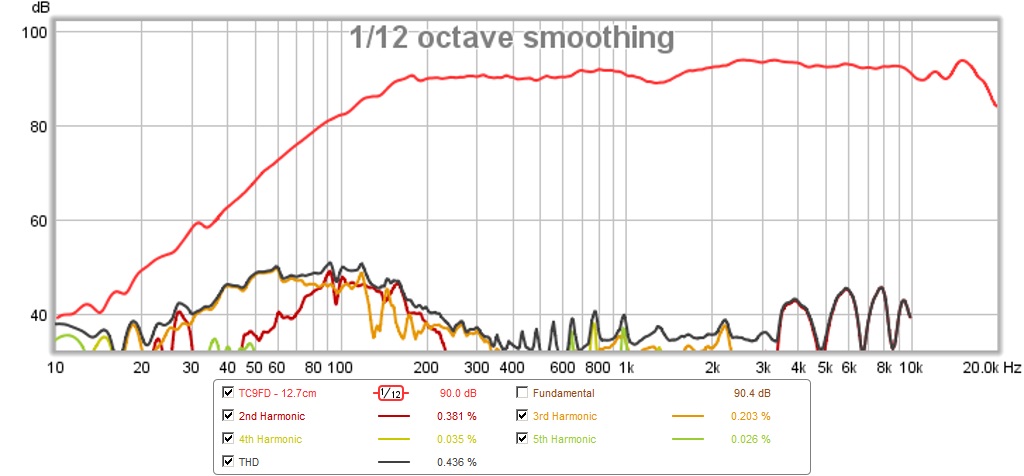
Here is the line-up of the intial drivers that were tested:
Vifa TC9FD (8 ohm paper cone), Faital Pro 3FE22 (4 ohm paper cone), 3FE22 (16 ohm paper cone), Dayton RS100-4 (4 ohm aluminum cone), RS100P-4 (4 ohm paper cone), Mark Audio CHN-70 (8 ohm paper cone), and Dayton Audio PS95-8 (8 ohm paper cone).
Here a photo of the drivers tested:
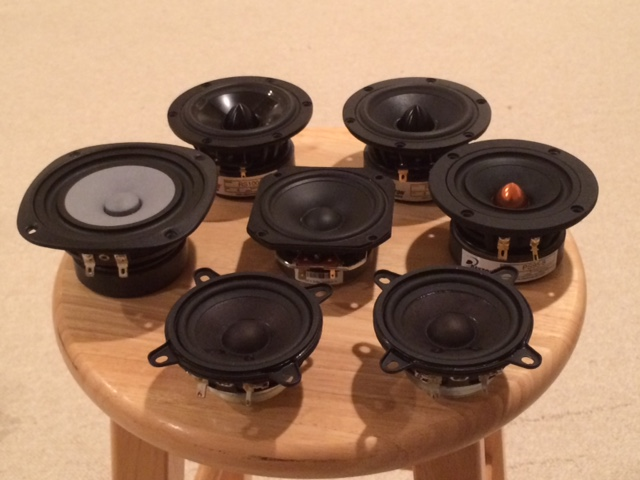
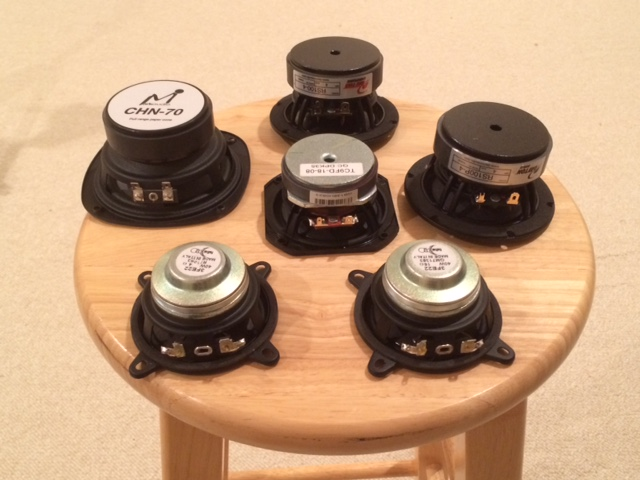
The test was conducted in an average sized home theater/media room in the basement of my house. Carpeted and mostly bare walls but lots of boxes and other speakers and audio gear in the room. My foam core speaker lab. The speaker was positioned about 5 ft from the corner and aimed 45 deg from wall to minimize back wall reflection interference. I perform the near field measurements with mic at 12.7cm away from the driver bezel and this really concentrates on the intrinsic driver response in the mid (above 200Hz) to HF's. Response for bass below 200Hz will be alignment dependent and not the topic of this thread. I also make measurements at 1 meter distance and 2.83v drive to check if the sensitivity is consistent with specs. The mic is a Dayton UMM-6 with factory calibration (checked to make sure it's not one of the defective calibration files that fluctuate), a custom TPA3116D2 amp (DUG PCB v0), an HP 110 netbook running REW 5.0 for the software and measurement system. I also have on hand a Dayton Audio DATS v2 woofer tester to look at impedance sweeps and perform T/S parameter measurements. Since the TC9FD is the driver I have worked with for the longest time and most familiar with, I will use it as a reference to compare the other drivers with.
Measurements now follow:
3FE22-4:
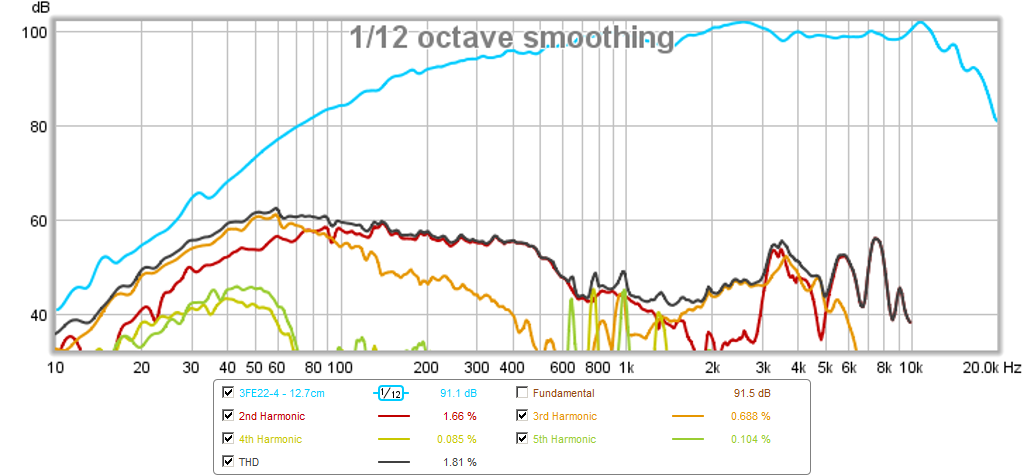
3FE22-4 vs the TC9FD:
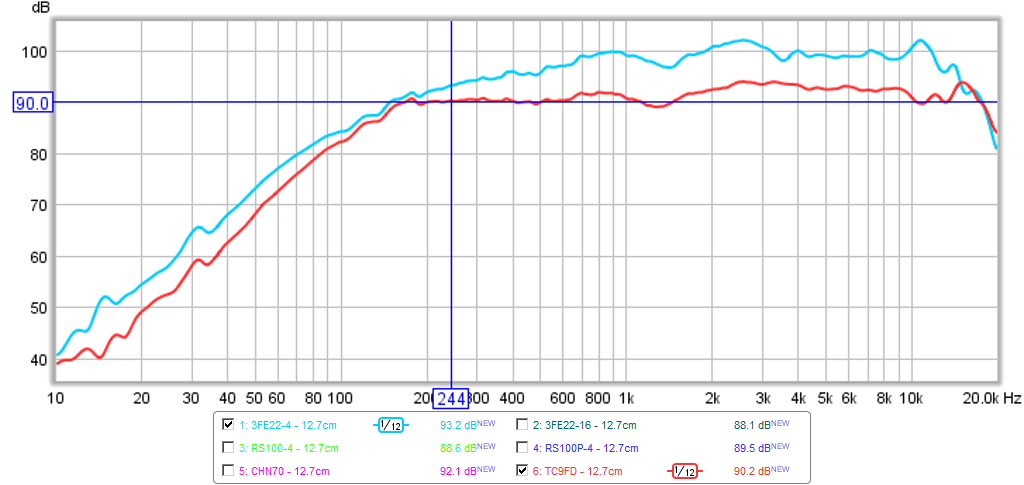
3FE22-16:
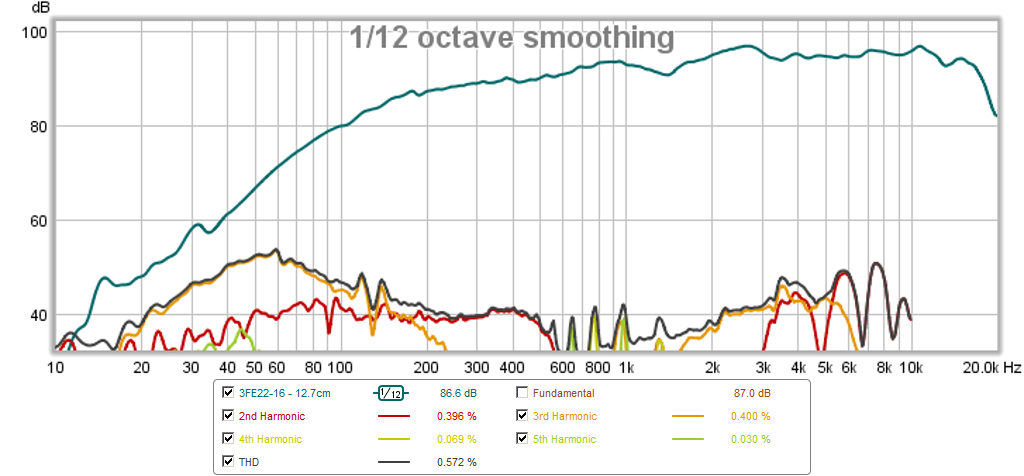
3FE22-16 vs TC9FD:
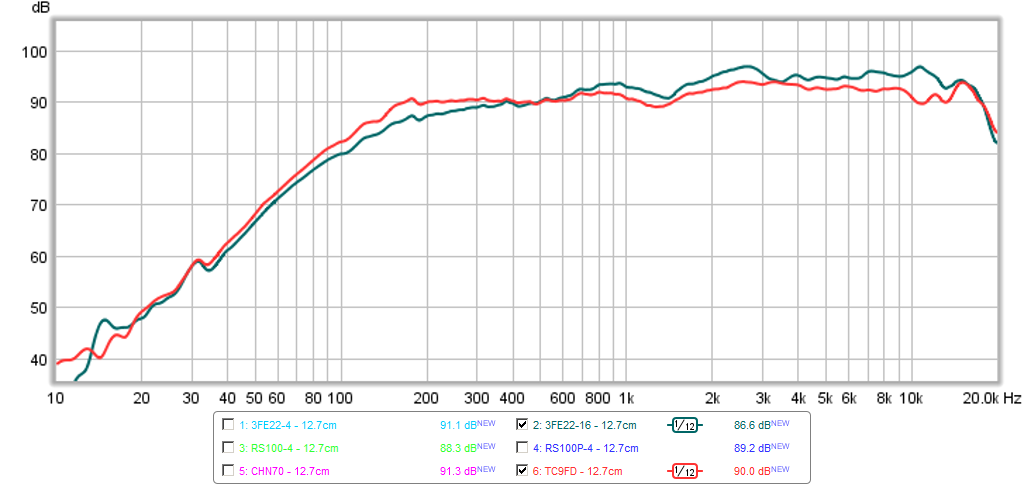
RS100-4:
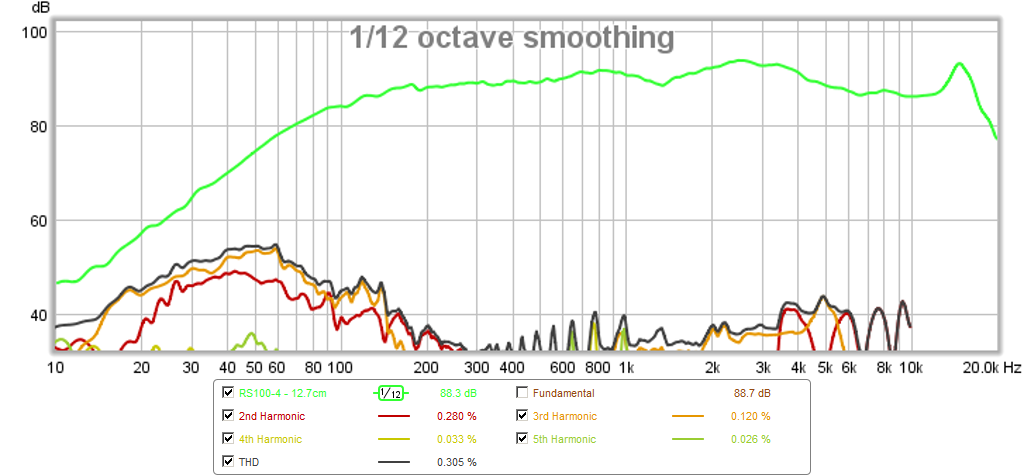
RS100-4 vs TC9FD:
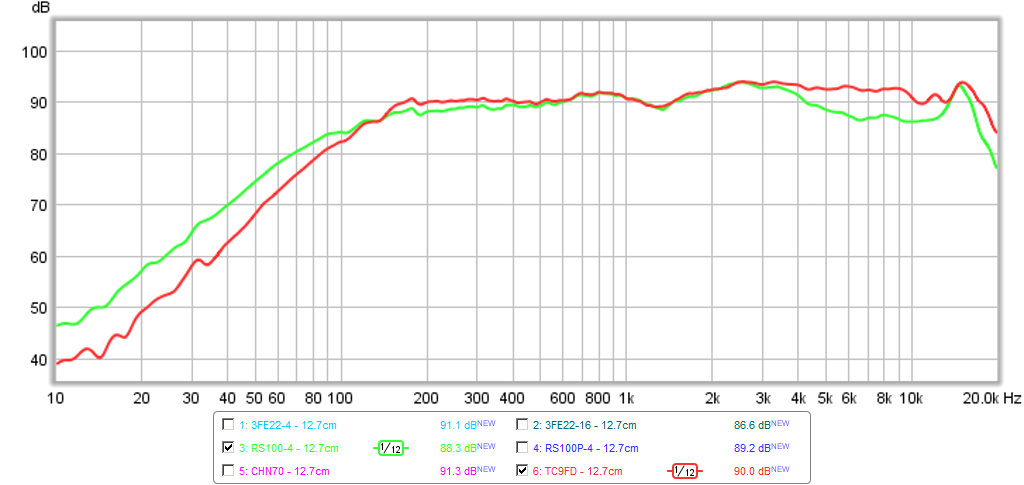
RS100P-4:
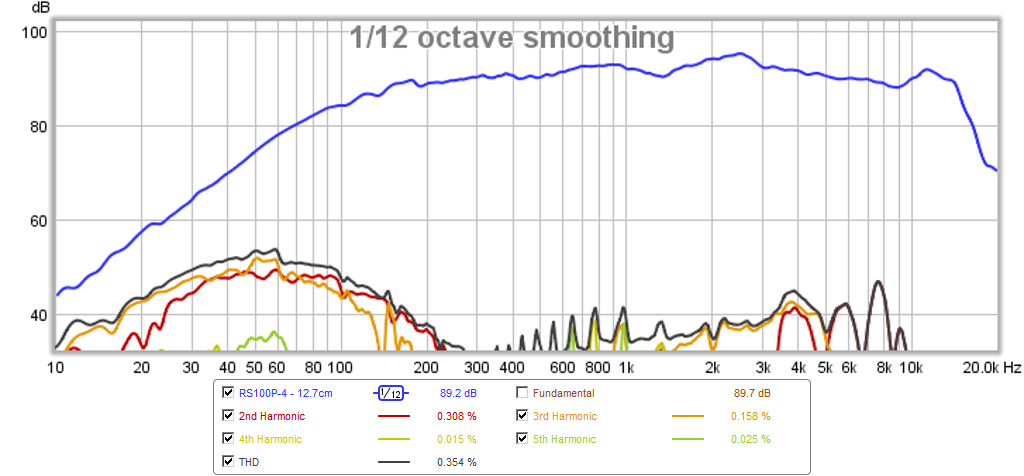
RS100P-4 vs TC9FD:
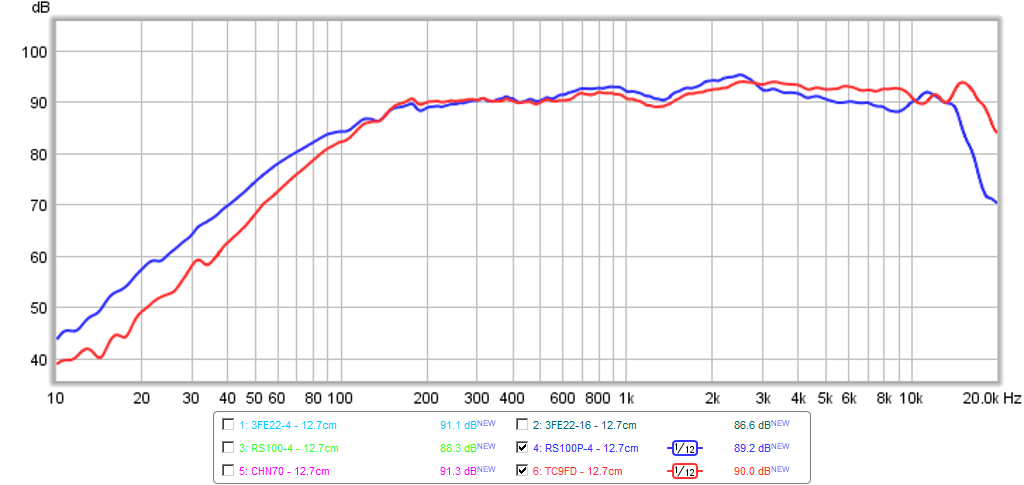
As you can see, the 3FE22-16 is probably the closest to the TC9FD in smoothness and flat response and reach. The 3FE22-4 is about the same but since it is a 4ohm driver, it has more excursion and more SPL so the HD is higher for same drive level. If you turn down drive level, probably about the same response as the 16ohm version (this may be a good option for those with high impedance tube amps). The aluminum cone RS100-4 has a sharp peak near 15kHz that will show up as ringing and sibilance. So far, the TC9FD is really the star here. The shallow depression near 1.4kHz appears to be consistent between drivers and is probably a characteristic of the Nautaloss cabinet.
The CHN-70 was a special case because it had an unusual response I took extra care to examine it in further detail to ensure that the measurement is good and that the cabinet was not the source of the dips observed.
Here is a photo of the CHN-70 in the trapezoidal supra-baffle Nautaloss setup:
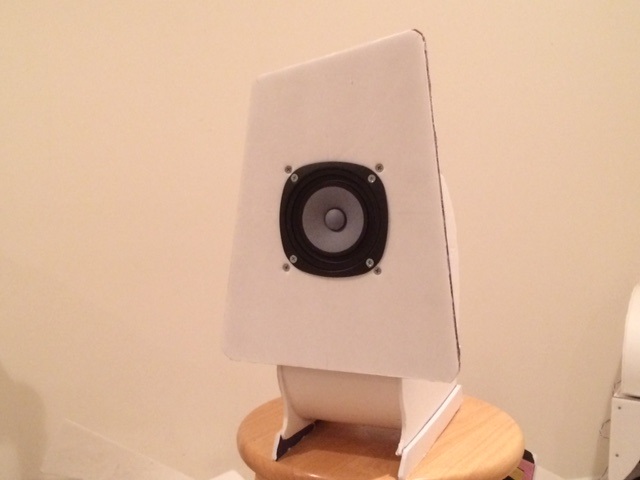
Upon measuring the response in the trapezoidal supra-baffle Nautaloss, I obtained the following response and harmonic distortion plot which was very puzzling: a big dip near 670Hz accompanied by high harmonic distortion there, and several other dips on high with a notable 12dB dip at 7kHz, and a rapid falloff above 12kHz. Initially, I thought my setup might be to blame, but none of the other drivers showed anything like this kind of response. In any event, I had to look deeper to make sure the measurement and enclosure were not the source of the dips and falloff.
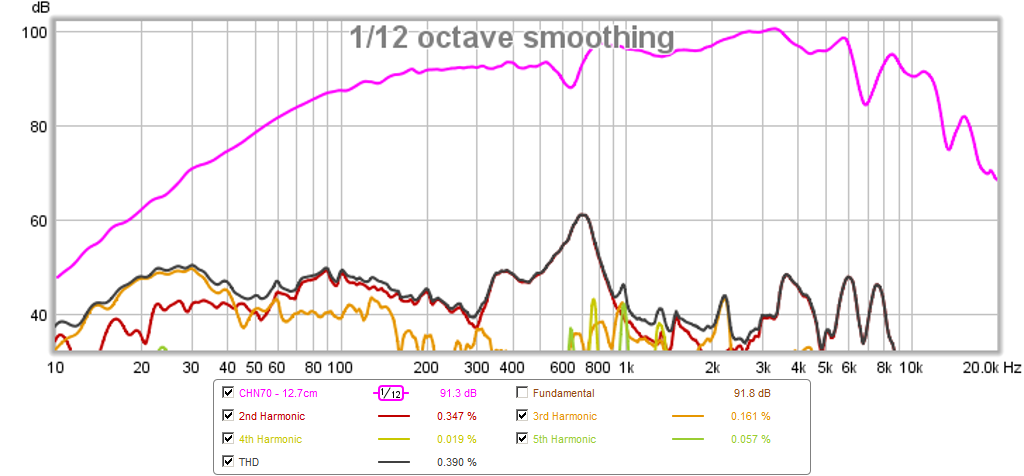
CHN-70 in OB:
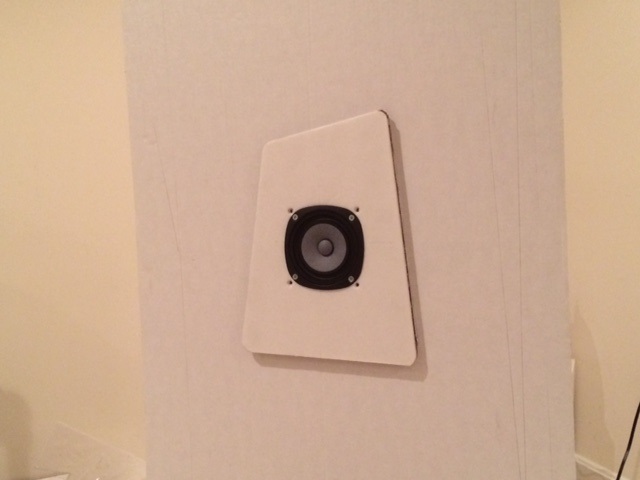
I thought that the Nautaloss chamber may be the source of this so I then proceeded to put it in a 24in wide x 36in tall open baffle and repeated the measurement. The OB data matches the Nautaloss data almost perfectly, which indicates that the dips are not caused by the enclosure. This test also shows that the trapezoidal supra baffle Nautaloss is very similar to an infinite baffle in that the rear chamber act's like a reflection free rear chamber.
Comparison of Nautaloss and OB response:
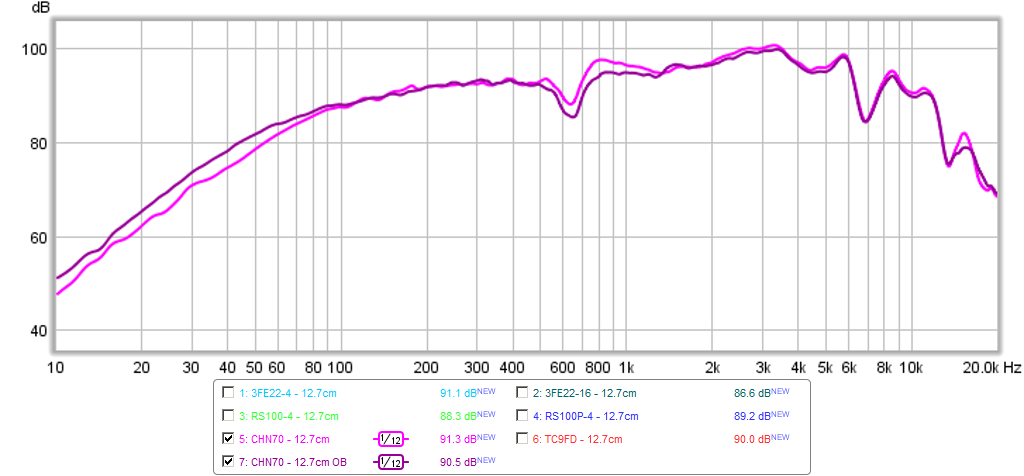
I then did an impedance sweep of the driver in the Nautaloss and in open air and see that the Nautaloss TL helps to smooth the impedance peak but there is a 700Hz peak corresponding to the dip and high HD, even in free air. I also measured the T/S parameters and the values are within family for the fs and Qts.
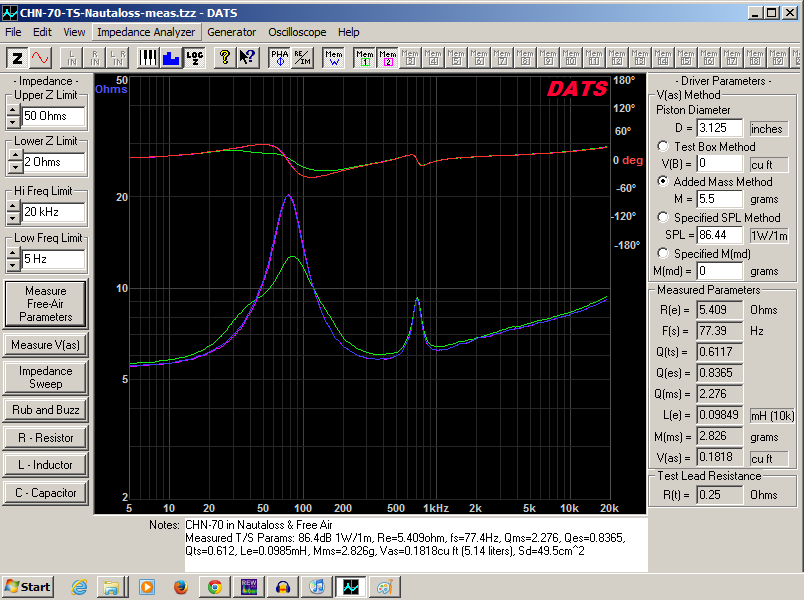
Based on this info, it appears that the dips and response seen are intrinsic to the driver and not the enclosure or the measurement method.
Here is a comparison of the CHN-70 and TC9FD:
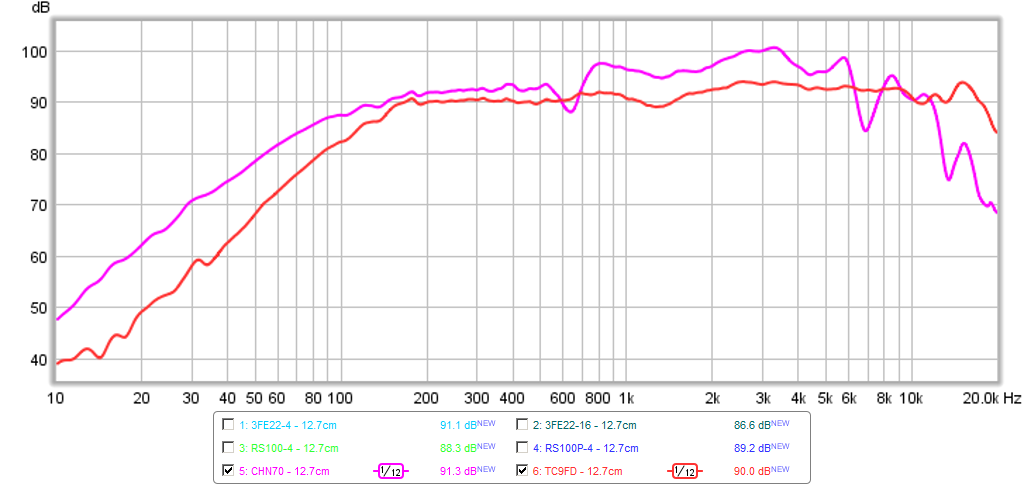
I also used a 670Hz sine wave generator and looked at the RTA to see what the distortion components look like. This is for 2.83v drive with mic at 1m away - most of the distortion is coming from the 2nd order.
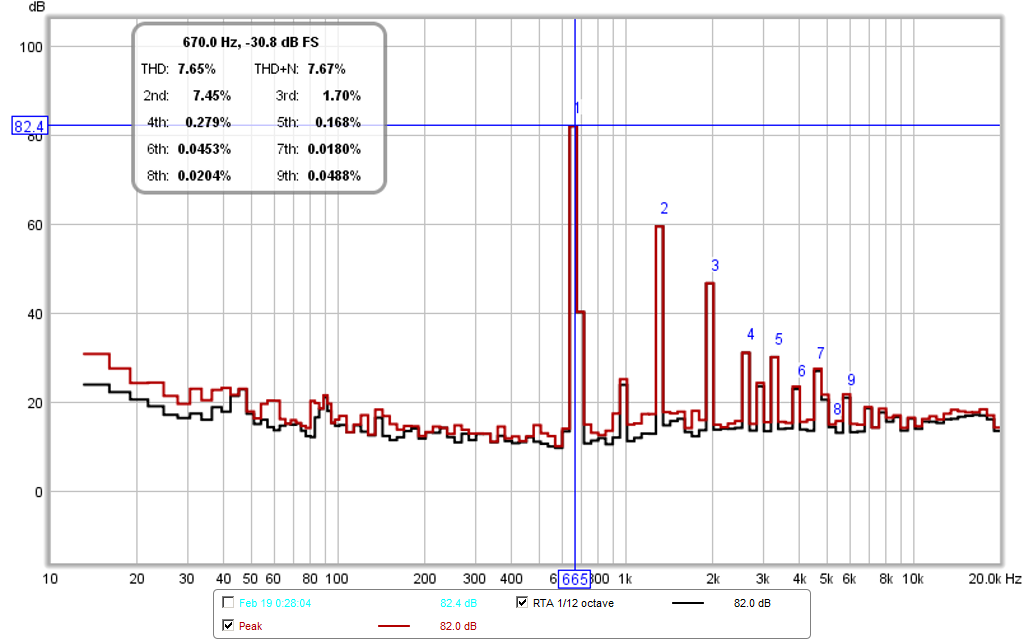
Given the very uneven response and its lack of HF extension, I think that the TC9FD is the clear winner. The CHN-70, will have better bass performance in an appropriate enclosure as it has a lower fs and more xmax, as well as a moderate Qts very suitable for MLTL's and BLH's. However, the very high distortion in the midrange and dips and peaks will color the sound from how it was intended to be heard. I really was hoping to find a good driver for use in full range applications here, unfortunately, that was not the finding. I want to make it clear that I really did try to repeat the measurement using other baffles, looked at the free air impedance sweep and the anomaly at 670Hz is there regardless. If anyone else has a measurement of a CHN-70, I would like your feedback to see if what I have is a fluke or defective unit.
Here is the PS95-8:
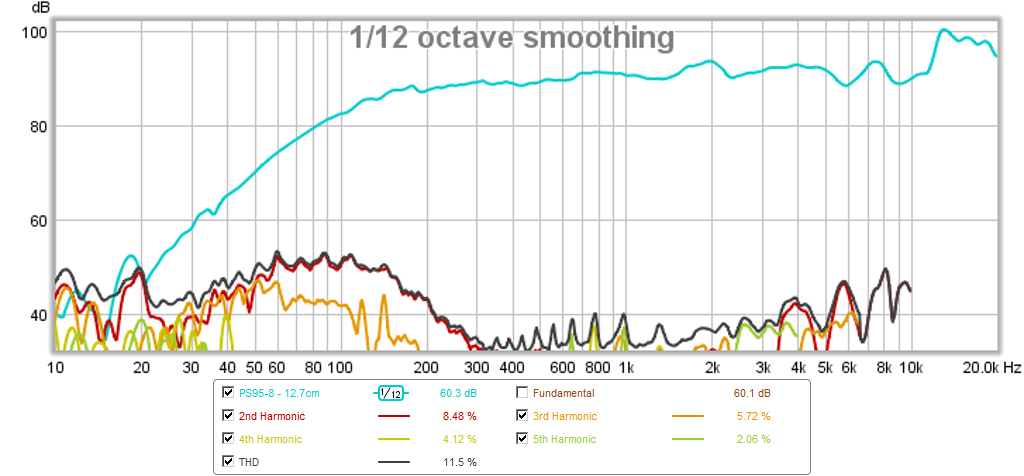
PS95-8 vs TC9FD:
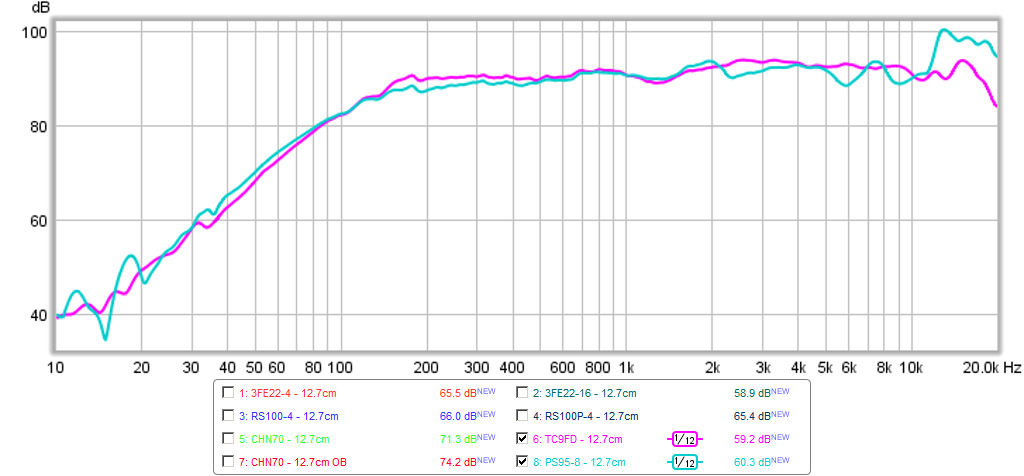
There are a couple of new drivers here that I have not listened to actually and thought perhaps folks would like to get a sense of what it can sound like. So I setup a FAST system using minDSP with a XO at 225Hz (-24dB/oct BW) using my dual Tang Band W5-876SE drivers in a dual vent XKi sub woofer of my own design for the bass duties from 30Hz to 225Hz, more info here: http://www.diyaudio.com/forums/full-range/268524-xki-xs-ab-initio-karlson-6th-order-bandpass-26.html#post4226956
The FAST setup allows us to listen to the full range driver, independent of a bass-augmentation alignment (such as bass reflex, MLTL, BLH, TQWT, etc) and allows all drivers to use the same bass system for an apples-to-apples comparison of their sound above 225Hz.
Here is the XO response for the PS95-8 in the FAST (there are two curves with and without EQ to flatten the driver response and you will hear a soundclip for each):
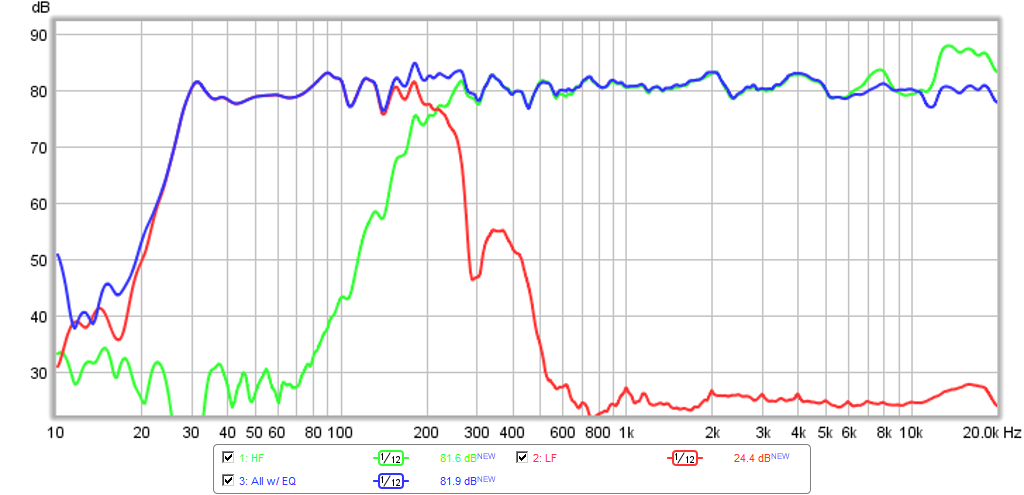
Harmonic Distortion of PS95-8 in FAST:
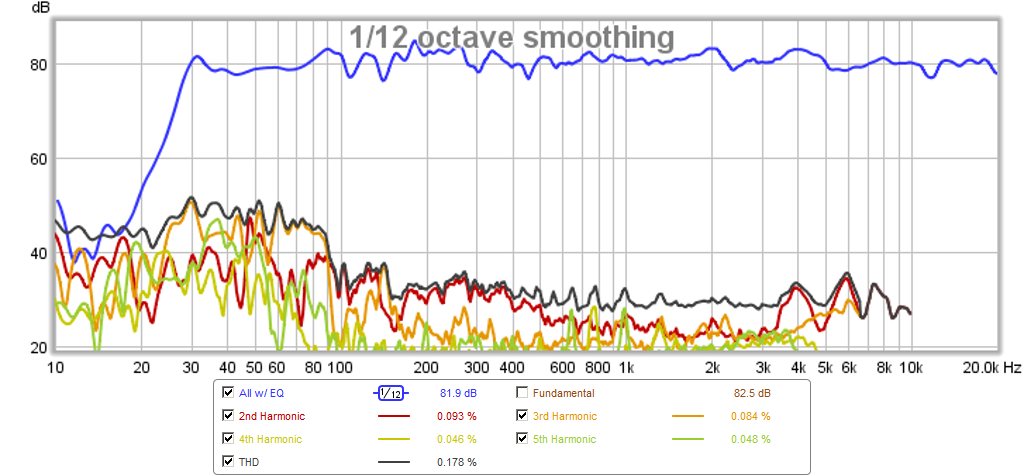
Impulse Response before EQ:
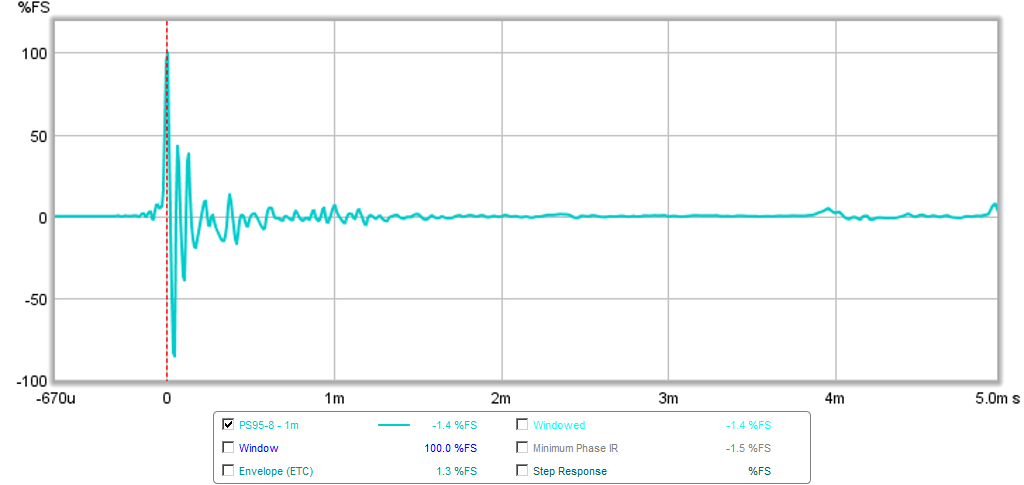
Impulse Response after EQ:
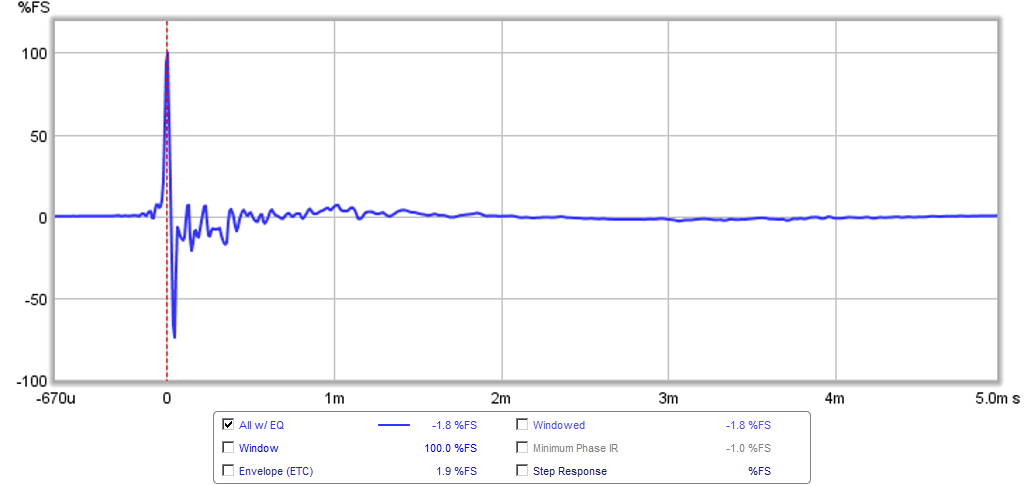
Sound clip of PS95-8 in FAST (no EQ):
http://www.diyaudio.com/forums/attachments/full-range/466976d1424412550-vifa-tc9fd18-08-best-bang-buck-ps95-xki-fast-no-eq.zip
Sound clip of PS95-8 in FAST (with EQ):
http://www.diyaudio.com/forums/attachments/full-range/466977d1424412550-vifa-tc9fd18-08-best-bang-buck-ps95-xki-fast-w-eq.zip
Same thing for the CHN-70 in the same FAST (same XO point):
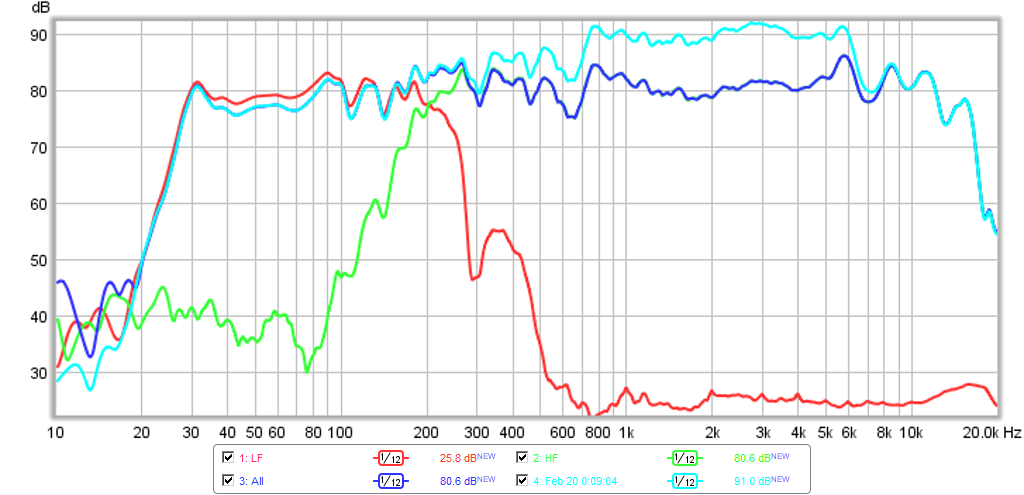
CHN-70 HD in FAST:
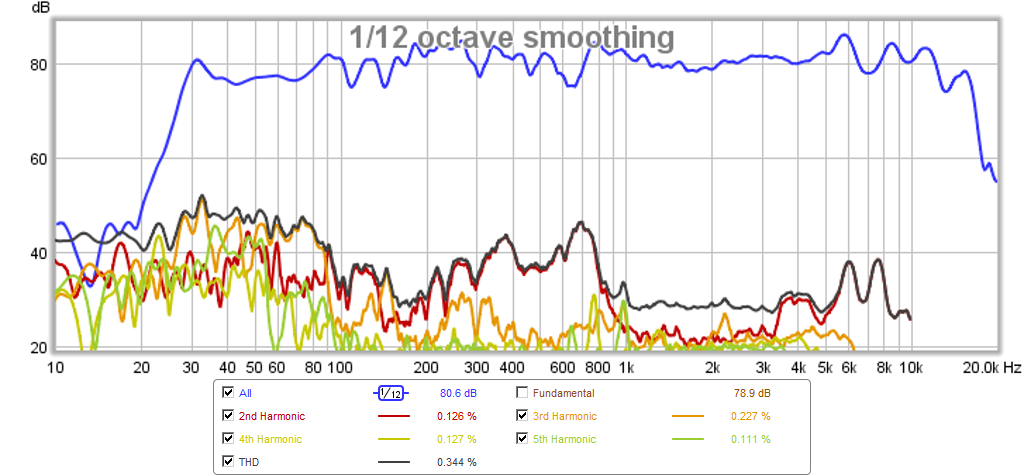
Impulse Response of CHN-70 in FAST (you don't want to see what it looks like without EQ):
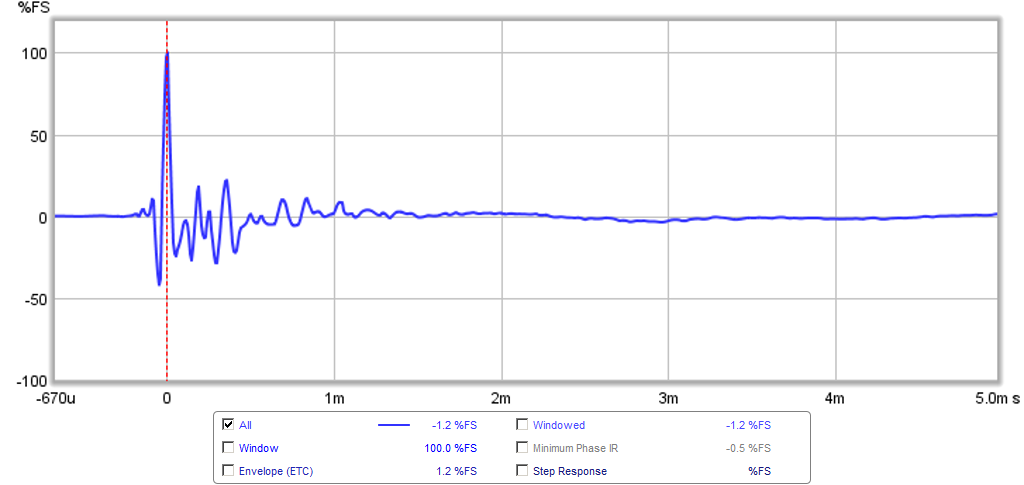
Sound clip of CHN-70 in FAST (no EQ):
http://www.diyaudio.com/forums/attachments/full-range/466964d1424411609-vifa-tc9fd18-08-best-bang-buck-chn70-xki-fast-no-eq.zip
Sound clip of CHN-70 in FAST (with EQ):
http://www.diyaudio.com/forums/attachments/full-range/466965d1424411609-vifa-tc9fd18-08-best-bang-buck-chn70-xki-fast-w-eq.zip
Edit (Feb 21, 2015): Polar data for the drivers measured at 0.5m and with 4ms gating can be found here: http://www.diyaudio.com/forums/full-range/270094-objective-comparison-3in-4in-class-full-range-drivers-9.html#post4231941
Here is an example of the polar data for the TC9FD:
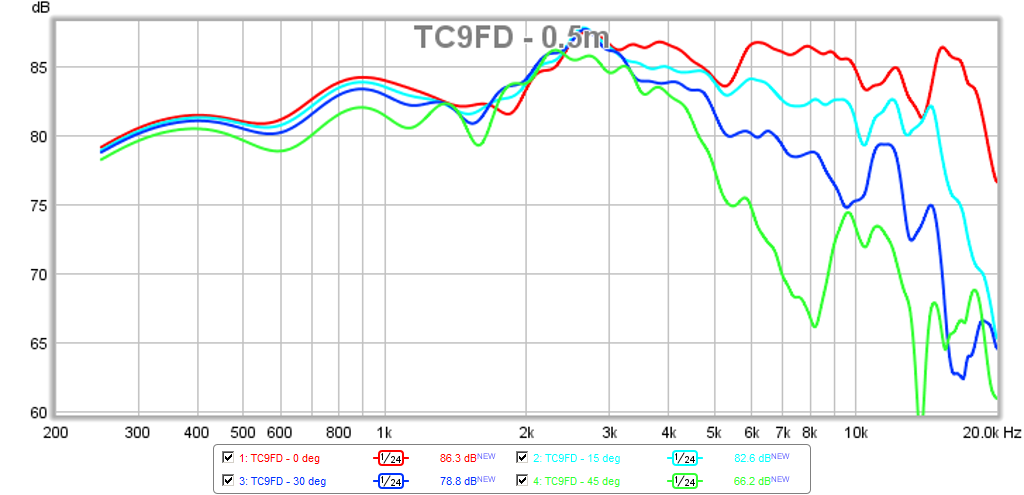
Further along in post #91, detailed comparisons at 5dB/div graphs like this can be found:
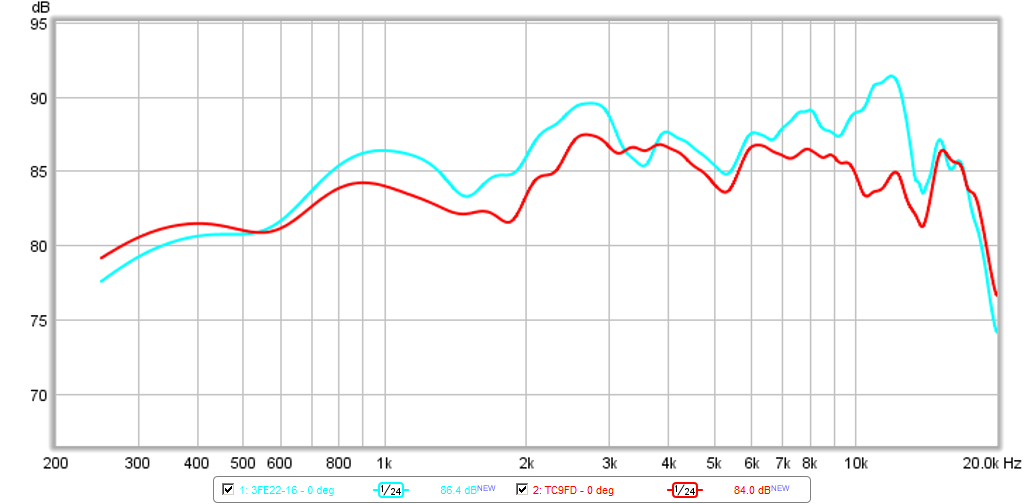
There is more data on spectral temporal decay plots (spectrograms) here:
http://www.diyaudio.com/forums/full-range/270094-objective-comparison-3in-4in-class-full-range-drivers-12.html#post4232351
An example of a spectrogram for the PS95-8 looks like this:
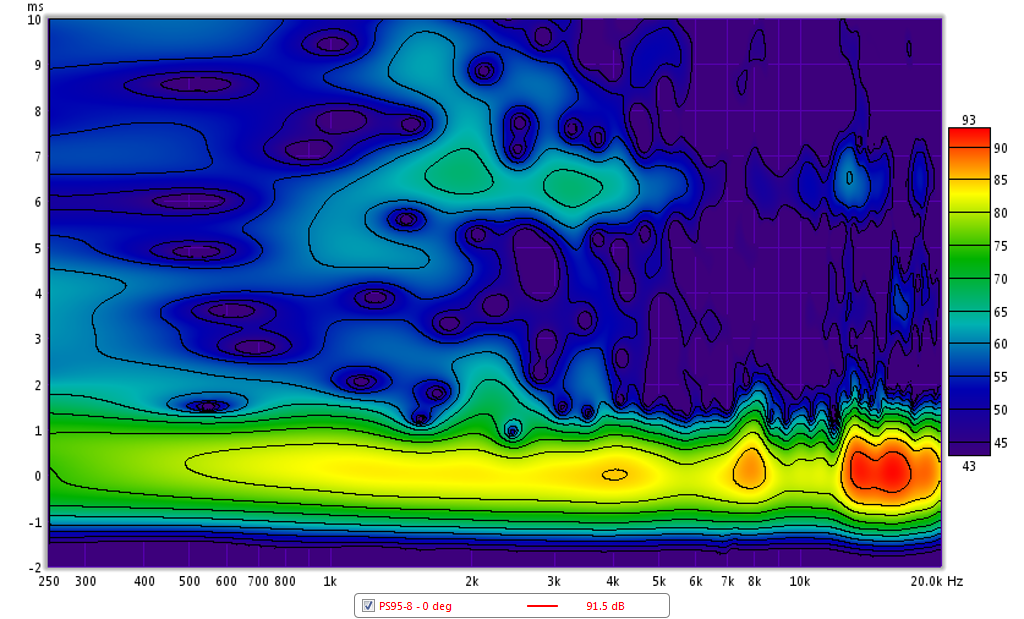
My approach was originally to use an IEC Standard 268-5 Baffle for drivers under 8 inches. It turns out that a baffle size of 1350 mm x 1650 mm (h, v) is huge (larger than any single piece of plywood you can buy) and not very practical for home use. I think that most diy'ers, even those going with an open baffle route will not utilize something quite this large.
So my approach was to have a moderate practical baffle, but one that minimizes baffle edge diffraction effects, and I wanted to contain the rear wave in a semi-infinite baffle type chamber - almost like cutting a hole in a wall and letting the adjacent room serve as the back chamber. One of my earlier designs has a performance and behavior very close to this but is compact. The Nautaloss is a sealed tapered spiral TL, more info here: http://www.diyaudio.com/forums/full-range/247598-nautaloss-ref-monitor.html. To the Nautaloss, I will fit a supra-baffle that is trapezoidal in shape with the driver offset from the center. This prevents any two distances from the driver to the edge being identical to minimize baffle edge diffraction/interference effects from causing rippling in the response.

Dimensions of trapezoidal supra-baffle (edge lengths): top=7.0in, bottom=12.0in, left=11.25in, right=13.0in. Driver centerline is 5.0in from left bottom corner and 6.0in up from bottom edge.
Here is the measurement in a trapezoidal supra-baffle mounted on the Nautaloss with a TC9FD. The measurement is near field with mic at 12.7cm away. I think the design seems to provide a very smooth response in the near-field.
TC9FD:

Here is the line-up of the intial drivers that were tested:
Vifa TC9FD (8 ohm paper cone), Faital Pro 3FE22 (4 ohm paper cone), 3FE22 (16 ohm paper cone), Dayton RS100-4 (4 ohm aluminum cone), RS100P-4 (4 ohm paper cone), Mark Audio CHN-70 (8 ohm paper cone), and Dayton Audio PS95-8 (8 ohm paper cone).
Here a photo of the drivers tested:


The test was conducted in an average sized home theater/media room in the basement of my house. Carpeted and mostly bare walls but lots of boxes and other speakers and audio gear in the room. My foam core speaker lab. The speaker was positioned about 5 ft from the corner and aimed 45 deg from wall to minimize back wall reflection interference. I perform the near field measurements with mic at 12.7cm away from the driver bezel and this really concentrates on the intrinsic driver response in the mid (above 200Hz) to HF's. Response for bass below 200Hz will be alignment dependent and not the topic of this thread. I also make measurements at 1 meter distance and 2.83v drive to check if the sensitivity is consistent with specs. The mic is a Dayton UMM-6 with factory calibration (checked to make sure it's not one of the defective calibration files that fluctuate), a custom TPA3116D2 amp (DUG PCB v0), an HP 110 netbook running REW 5.0 for the software and measurement system. I also have on hand a Dayton Audio DATS v2 woofer tester to look at impedance sweeps and perform T/S parameter measurements. Since the TC9FD is the driver I have worked with for the longest time and most familiar with, I will use it as a reference to compare the other drivers with.
Measurements now follow:
3FE22-4:

3FE22-4 vs the TC9FD:

3FE22-16:

3FE22-16 vs TC9FD:

RS100-4:

RS100-4 vs TC9FD:

RS100P-4:

RS100P-4 vs TC9FD:

As you can see, the 3FE22-16 is probably the closest to the TC9FD in smoothness and flat response and reach. The 3FE22-4 is about the same but since it is a 4ohm driver, it has more excursion and more SPL so the HD is higher for same drive level. If you turn down drive level, probably about the same response as the 16ohm version (this may be a good option for those with high impedance tube amps). The aluminum cone RS100-4 has a sharp peak near 15kHz that will show up as ringing and sibilance. So far, the TC9FD is really the star here. The shallow depression near 1.4kHz appears to be consistent between drivers and is probably a characteristic of the Nautaloss cabinet.
The CHN-70 was a special case because it had an unusual response I took extra care to examine it in further detail to ensure that the measurement is good and that the cabinet was not the source of the dips observed.
Here is a photo of the CHN-70 in the trapezoidal supra-baffle Nautaloss setup:

Upon measuring the response in the trapezoidal supra-baffle Nautaloss, I obtained the following response and harmonic distortion plot which was very puzzling: a big dip near 670Hz accompanied by high harmonic distortion there, and several other dips on high with a notable 12dB dip at 7kHz, and a rapid falloff above 12kHz. Initially, I thought my setup might be to blame, but none of the other drivers showed anything like this kind of response. In any event, I had to look deeper to make sure the measurement and enclosure were not the source of the dips and falloff.

CHN-70 in OB:

I thought that the Nautaloss chamber may be the source of this so I then proceeded to put it in a 24in wide x 36in tall open baffle and repeated the measurement. The OB data matches the Nautaloss data almost perfectly, which indicates that the dips are not caused by the enclosure. This test also shows that the trapezoidal supra baffle Nautaloss is very similar to an infinite baffle in that the rear chamber act's like a reflection free rear chamber.
Comparison of Nautaloss and OB response:

I then did an impedance sweep of the driver in the Nautaloss and in open air and see that the Nautaloss TL helps to smooth the impedance peak but there is a 700Hz peak corresponding to the dip and high HD, even in free air. I also measured the T/S parameters and the values are within family for the fs and Qts.

Based on this info, it appears that the dips and response seen are intrinsic to the driver and not the enclosure or the measurement method.
Here is a comparison of the CHN-70 and TC9FD:

I also used a 670Hz sine wave generator and looked at the RTA to see what the distortion components look like. This is for 2.83v drive with mic at 1m away - most of the distortion is coming from the 2nd order.

Given the very uneven response and its lack of HF extension, I think that the TC9FD is the clear winner. The CHN-70, will have better bass performance in an appropriate enclosure as it has a lower fs and more xmax, as well as a moderate Qts very suitable for MLTL's and BLH's. However, the very high distortion in the midrange and dips and peaks will color the sound from how it was intended to be heard. I really was hoping to find a good driver for use in full range applications here, unfortunately, that was not the finding. I want to make it clear that I really did try to repeat the measurement using other baffles, looked at the free air impedance sweep and the anomaly at 670Hz is there regardless. If anyone else has a measurement of a CHN-70, I would like your feedback to see if what I have is a fluke or defective unit.
Here is the PS95-8:

PS95-8 vs TC9FD:

There are a couple of new drivers here that I have not listened to actually and thought perhaps folks would like to get a sense of what it can sound like. So I setup a FAST system using minDSP with a XO at 225Hz (-24dB/oct BW) using my dual Tang Band W5-876SE drivers in a dual vent XKi sub woofer of my own design for the bass duties from 30Hz to 225Hz, more info here: http://www.diyaudio.com/forums/full-range/268524-xki-xs-ab-initio-karlson-6th-order-bandpass-26.html#post4226956
The FAST setup allows us to listen to the full range driver, independent of a bass-augmentation alignment (such as bass reflex, MLTL, BLH, TQWT, etc) and allows all drivers to use the same bass system for an apples-to-apples comparison of their sound above 225Hz.
Here is the XO response for the PS95-8 in the FAST (there are two curves with and without EQ to flatten the driver response and you will hear a soundclip for each):

Harmonic Distortion of PS95-8 in FAST:

Impulse Response before EQ:

Impulse Response after EQ:

Sound clip of PS95-8 in FAST (no EQ):
http://www.diyaudio.com/forums/attachments/full-range/466976d1424412550-vifa-tc9fd18-08-best-bang-buck-ps95-xki-fast-no-eq.zip
Sound clip of PS95-8 in FAST (with EQ):
http://www.diyaudio.com/forums/attachments/full-range/466977d1424412550-vifa-tc9fd18-08-best-bang-buck-ps95-xki-fast-w-eq.zip
Same thing for the CHN-70 in the same FAST (same XO point):

CHN-70 HD in FAST:

Impulse Response of CHN-70 in FAST (you don't want to see what it looks like without EQ):

Sound clip of CHN-70 in FAST (no EQ):
http://www.diyaudio.com/forums/attachments/full-range/466964d1424411609-vifa-tc9fd18-08-best-bang-buck-chn70-xki-fast-no-eq.zip
Sound clip of CHN-70 in FAST (with EQ):
http://www.diyaudio.com/forums/attachments/full-range/466965d1424411609-vifa-tc9fd18-08-best-bang-buck-chn70-xki-fast-w-eq.zip
Edit (Feb 21, 2015): Polar data for the drivers measured at 0.5m and with 4ms gating can be found here: http://www.diyaudio.com/forums/full-range/270094-objective-comparison-3in-4in-class-full-range-drivers-9.html#post4231941
Here is an example of the polar data for the TC9FD:

Further along in post #91, detailed comparisons at 5dB/div graphs like this can be found:

There is more data on spectral temporal decay plots (spectrograms) here:
http://www.diyaudio.com/forums/full-range/270094-objective-comparison-3in-4in-class-full-range-drivers-12.html#post4232351
An example of a spectrogram for the PS95-8 looks like this:

Last edited:
Hi X - - - this is an interesting and helpful survey data and listening wise so far.
Vifa's TC9FD has earned a place for a reference driver with regards to smoothness - PS95-8 seems to be a bargain and high performer - its rise at the top octave may level somewhat off axis and I thought it fared quite well without any EQ in its FAST clip.
CHN70 has an elevated plateau and a somewhat early HF rolloff - the deviation from level response makes it sound different than PS95-8 - - I'm not sure if the distortion peak excited with 670Hz sine itself has a lot of negative impact. Perhaps CHN70 has some advantage with lower power amps.
Why might Faital's 16ohm driver have the more extended HF corner than the 4ohm unit?
I think Pidegon's recording has "some" vocal processing - here's a sample of it "dry" http://www.amazon.com/Spanish-Harlem/dp/B00AIGGR1W
btw, your little dual 5" XKi helper-sub seems to be a potent performer.
a 4" Faital might be nice to include sometime in this survey.
Vifa's TC9FD has earned a place for a reference driver with regards to smoothness - PS95-8 seems to be a bargain and high performer - its rise at the top octave may level somewhat off axis and I thought it fared quite well without any EQ in its FAST clip.
CHN70 has an elevated plateau and a somewhat early HF rolloff - the deviation from level response makes it sound different than PS95-8 - - I'm not sure if the distortion peak excited with 670Hz sine itself has a lot of negative impact. Perhaps CHN70 has some advantage with lower power amps.
Why might Faital's 16ohm driver have the more extended HF corner than the 4ohm unit?
I think Pidegon's recording has "some" vocal processing - here's a sample of it "dry" http://www.amazon.com/Spanish-Harlem/dp/B00AIGGR1W
btw, your little dual 5" XKi helper-sub seems to be a potent performer.
a 4" Faital might be nice to include sometime in this survey.
Hi Freddi,
I agree that the PS95 sounds very good without the EQ - not objectionable in any way really. A fine little unit for $23 - can't beat the value for build quality on that driver. Nice cast frame, inverted rubber surround, copper phase plug, nice paper cone, fat magnet, gold terminals, copper shorting ring - a lot of higher end features for price of a budget driver. The CHN-70, by comparison, is no where near the same level of build quality and fit and finish.
This is the level of quality you can get for $23 nowadays, the bar has really been raised in 3in class full range arena:
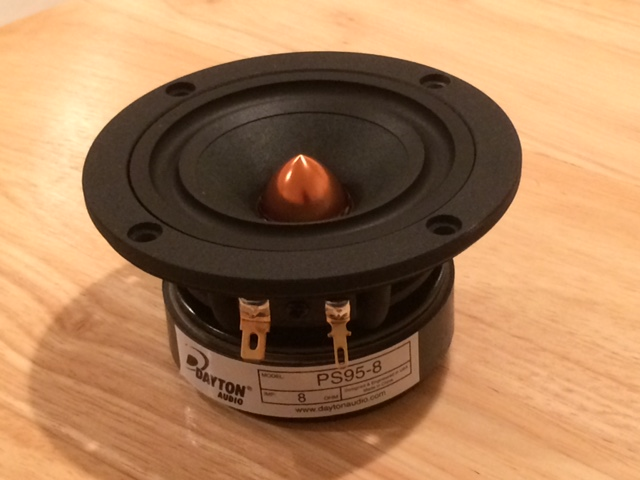
That's interesting that the 16ohm Faital appears to have higher frequency reach than the 4ohm. I thought that there might be some sonic benefits rather than just purely an impedance match for some amps. It may have to do with the thickness of the wire and reduced mass of the windings for 16ohm?
The CHN-70 has an elevated plateau that sounds very harsh to my ears and almost unlistenable without EQ to remove. Once EQ'd it sounds quite pleasant.
That's interesting that you think there is some processing going on with the Spanish Harlem track. I played it directly off the Raven CD, which I assume, would be the source of the compilation that you linked.
I have heard good things about the 4in Faital 4FE32 and 4FE35 - the measurements of the 4FE35 posted elsewhere show it to be a good performer but may have a breakup peak around 8kHz that may have to be dealt with. I have heard test clips of the 4FE32 in a DCR that I designed and a friend built and they sounded good.
XKi sub with dual W5-876SE's:
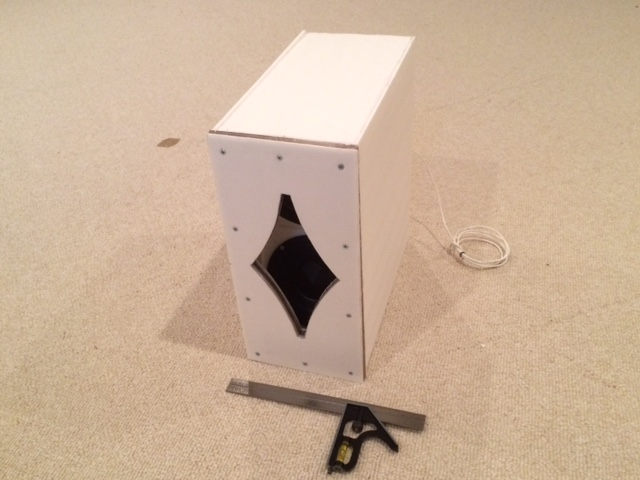
The XKi dual 5in sub is an interesting box, and I can see it as a standard modular bass unit for a lot of my FAST applications where I can afford to cross as low as 225Hz (it can't go much higher). But it's compact size, low weight, and wide bandwidth from 30Hz to 225Hz are really useful. As I have demonstrated, with this sub, a miniDSP, a TPA3116D2, you can pretty much throw any full range driver at it and get a decent sounding FAST system in a jiffy. These FAST systems take me maybe 5 minutes to setup once I have the bass unit and miniDSP connected with a mic and REW up and running.
I agree that the PS95 sounds very good without the EQ - not objectionable in any way really. A fine little unit for $23 - can't beat the value for build quality on that driver. Nice cast frame, inverted rubber surround, copper phase plug, nice paper cone, fat magnet, gold terminals, copper shorting ring - a lot of higher end features for price of a budget driver. The CHN-70, by comparison, is no where near the same level of build quality and fit and finish.
This is the level of quality you can get for $23 nowadays, the bar has really been raised in 3in class full range arena:

That's interesting that the 16ohm Faital appears to have higher frequency reach than the 4ohm. I thought that there might be some sonic benefits rather than just purely an impedance match for some amps. It may have to do with the thickness of the wire and reduced mass of the windings for 16ohm?
The CHN-70 has an elevated plateau that sounds very harsh to my ears and almost unlistenable without EQ to remove. Once EQ'd it sounds quite pleasant.
That's interesting that you think there is some processing going on with the Spanish Harlem track. I played it directly off the Raven CD, which I assume, would be the source of the compilation that you linked.
I have heard good things about the 4in Faital 4FE32 and 4FE35 - the measurements of the 4FE35 posted elsewhere show it to be a good performer but may have a breakup peak around 8kHz that may have to be dealt with. I have heard test clips of the 4FE32 in a DCR that I designed and a friend built and they sounded good.
XKi sub with dual W5-876SE's:

The XKi dual 5in sub is an interesting box, and I can see it as a standard modular bass unit for a lot of my FAST applications where I can afford to cross as low as 225Hz (it can't go much higher). But it's compact size, low weight, and wide bandwidth from 30Hz to 225Hz are really useful. As I have demonstrated, with this sub, a miniDSP, a TPA3116D2, you can pretty much throw any full range driver at it and get a decent sounding FAST system in a jiffy. These FAST systems take me maybe 5 minutes to setup once I have the bass unit and miniDSP connected with a mic and REW up and running.
Last edited:
FWIW, I think there were good vocal recordings 50-60 years ago which sounded "natural" - there were decent condenser and ribbon mics, tube electronics in those days. It would be nice if someone with more knowledge than myself would pull up some examples for another thread. A lot was on vinyl. I guess for male vocals, Muddy Water's "Folk Singer" and "Sings Big Bill Broonzy" might be considered pretty nice recordings even today.
Last edited:
I wasn't aware there are new Vifa's with hot top end? This is te same TC9FD-18-08 I have bought for years. The one tested came out of my Nautaloss II and is a little over a year old. Are the specs different or is it just production variability? I have found the TC9FD to be very consistent.
Rutchko has a great website and is covering the gamut of full range drivers. I am concentrating on 3-4in size. For many of the MA drivers, there is also an impedence blip in the 500Hz to 700Hz range and I suspect this may have something to do with the built-in "baffle step compensation" or mechanical xo point via some sort of clever cone-to-suspension mechanical coupling used to extract extra bass below the blip. In the case of the CHN-70 that is 700Hz and it's at 550Hz on the A10P.
Last edited:
Cool comparison.
I too have found similar impedance blips associated with high Q nulls in the midrange on MA drivers. Never that bad, though this is their lower end unit right?
xrk971, could you use a 5db scale and maybe 200 to 20khz range? That would help see the details a little better.
Beware at that measurement distance it's very easy to be off on distance and angle. Even 5mm makes a (small) difference at that distance. You'd be much better off going outdoors and raising it up a couple meters and measuring from 0.5m. The setup will be much more tolerant of changes. And you could set about a 12ms window at that range. You could also build a generic 10L sealed box with interchangeable baffles.
I too have found similar impedance blips associated with high Q nulls in the midrange on MA drivers. Never that bad, though this is their lower end unit right?
xrk971, could you use a 5db scale and maybe 200 to 20khz range? That would help see the details a little better.
Beware at that measurement distance it's very easy to be off on distance and angle. Even 5mm makes a (small) difference at that distance. You'd be much better off going outdoors and raising it up a couple meters and measuring from 0.5m. The setup will be much more tolerant of changes. And you could set about a 12ms window at that range. You could also build a generic 10L sealed box with interchangeable baffles.
For many of the MA drivers, there is also an impedence blip in the 500Hz to 700Hz range and I suspect this may have something to do with the built-in "baffle step compensation" or mechanical xo point via some sort of clever cone-to-suspension mechanical coupling
To be a FR driver it has to transition from pistonic to resonant behaviour at some point. The inflection point is at the impedance bump on the MAs.
dave
Tux,
The 5dB scale will come later when I have time to redo the graphs on a bigger screen. I use a piece of 12.7cm long foam core as a "depth gauge" to set the driver to mic distance and alignment. It is referenced to bezel. Yes, outdoors would be more anechoic like. One other side benefit of doing it in my basement is the fact that it is 3 deg F windy as heck and snowy outside. I like to stay warm and keep my drivers warm a side benefit is that I want to show that regular in home measurements can reveal intrinsic properties of the driver independent of the room and enclosure. Use a big sealed box, or in my case, a Nautaloss sealed spiral TL as that was handy.
a side benefit is that I want to show that regular in home measurements can reveal intrinsic properties of the driver independent of the room and enclosure. Use a big sealed box, or in my case, a Nautaloss sealed spiral TL as that was handy.
The 5dB scale will come later when I have time to redo the graphs on a bigger screen. I use a piece of 12.7cm long foam core as a "depth gauge" to set the driver to mic distance and alignment. It is referenced to bezel. Yes, outdoors would be more anechoic like. One other side benefit of doing it in my basement is the fact that it is 3 deg F windy as heck and snowy outside. I like to stay warm and keep my drivers warm
I use a piece of 12.7cm long foam core as a "depth gauge" to set the driver to mic distance
That is getting pretty close to being a nearfield measurement -- particularily with the larger drivers -- which would lead to inaccurate results. You should also beonly plotting to the LF limit of your measurements.
dave
Tux,
The 5dB scale will come later when I have time to redo the graphs on a bigger screen. I use a piece of 12.7cm long foam core as a "depth gauge" to set the driver to mic distance and alignment. It is referenced to bezel. Yes, outdoors would be more anechoic like. One other side benefit of doing it in my basement is the fact that it is 3 deg F windy as heck and snowy outside. I like to stay warm and keep my drivers warma side benefit is that I want to show that regular in home measurements can reveal intrinsic properties of the driver independent of the room and enclosure. Use a big sealed box, or in my case, a Nautaloss sealed spiral TL as that was handy.
12.7 cm is about 5 inches. That's very much near field. You need to be more than 5 times the driver diameter to be in the far field. I would say about 1m is a good distance for this size.
Thanks for providing measurements!
The Vifa and Daytons look good to me. The Daytons are especially attractive given the price and ability to match with larger variants in the Reference line for building a FAST setup.
xrk, do you have any issues with imaging/stage with a single bass unit? I see it yields a great frequency response, but bass above 80hz is not omnidirectional and I would think the crossover at ~200-250hz would have an effect on the sound.
The Vifa and Daytons look good to me. The Daytons are especially attractive given the price and ability to match with larger variants in the Reference line for building a FAST setup.
xrk, do you have any issues with imaging/stage with a single bass unit? I see it yields a great frequency response, but bass above 80hz is not omnidirectional and I would think the crossover at ~200-250hz would have an effect on the sound.
That is getting pretty close to being a nearfield measurement -- particularily with the larger drivers -- which would lead to inaccurate results. You should also beonly plotting to the LF limit of your measurements.
dave
Ah, didn't realize it's so cold where you are. It's in the 50s here lately so chilly, but doable.
You can get useful info indoors, it's just harder and limited. Still useful though.
Wish probably as you CHN70 performed better but don't think we can change much unless drivers are defect.
Please take a look (study) all the drivers manufacture datasheets and discover xrk971 data are so close a tendency to those that this should prove it's possible to measure in a home environment, and another good argument is that it's factual in home environment we listen to speakers so had there bean difference we couldn't care less because we don't have anechoic chambers the house. The CHN70 datasheet is not close in frequency response but probably what measured at manufacture pro environment, the impedance spike is more problematic to explain in it shows ~0,75 ohm spike at datasheet in free air where free air at xrk971 place show whoopy ~3,0 ohm.
And last thing is all drivers treated equal and even if xrk971 hardware not 100% reference equipment all drivers sat in that same chain thereby from this setup particular measured data is compareable.
Last edited:
BRYTT, certainly. It's very comparable and certainly reliable. There's just some things I felt could be improved like the scale. I think it's hard to draw rigid conclusions on this data as presented, so I look forward to seeing more.
I hear often that the manufacturer's data should be held in higher regard than the enthusiasts. I don't accept this. I say it depends. When you have multiple sources with credible setups saying the same thing, and a manufacturer saying another I'm suspicious. When that manufacturer shows data that is simple unbelievable (extended, breakup free, smooth, etc) on top of the contrary third party results, I don't believe it. For myself, I've found this to be the case with MA products. This doesn't mean I don't find them to sound good. And they usually measure well. Just not as good as they advertise.
I hear often that the manufacturer's data should be held in higher regard than the enthusiasts. I don't accept this. I say it depends. When you have multiple sources with credible setups saying the same thing, and a manufacturer saying another I'm suspicious. When that manufacturer shows data that is simple unbelievable (extended, breakup free, smooth, etc) on top of the contrary third party results, I don't believe it. For myself, I've found this to be the case with MA products. This doesn't mean I don't find them to sound good. And they usually measure well. Just not as good as they advertise.
Measurements at 1m per your requests
Per members' requests for: 5dB increments, 1 meter distance, 2.83v drive level, 5 ms gating to remove low frequency room effects (don't look below 200Hz), 1/48th octave smoothing, etc. Distance measured with a ruler from driver bezel to mic at driver centerline axis. The manufacturer's rated SPL sensitivity matches pretty closely what I measure, an indication that my calibration is OK on absolute SPL scale. I am new at using gating in REW, I set to 5ms, which means 100Hz resolution, and nothing below 200Hz is any good. Let me know if this is an incorrect setting to use for displaying the data to remove room effects.
TC9FD vs 3FE22-4:
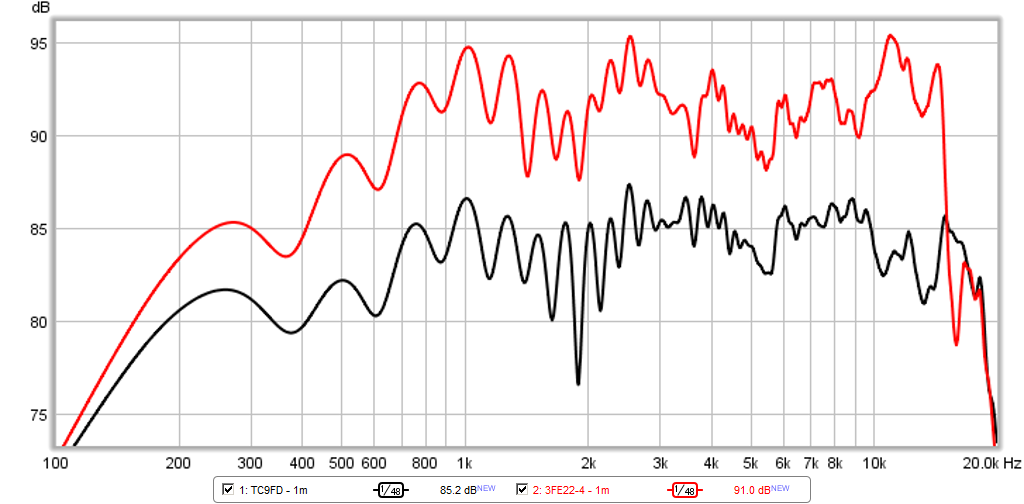
TC9FD vs 3FE22-16:
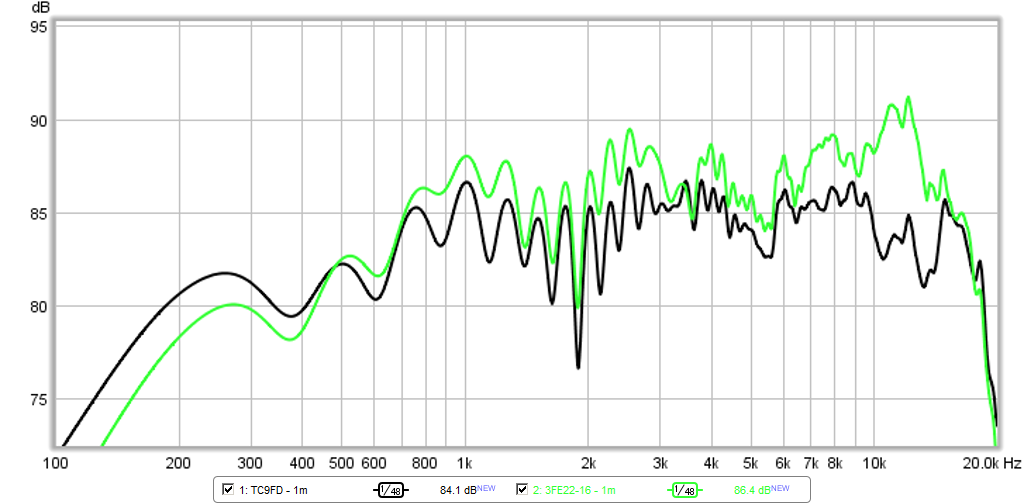
TC9FD vs RS100-4:
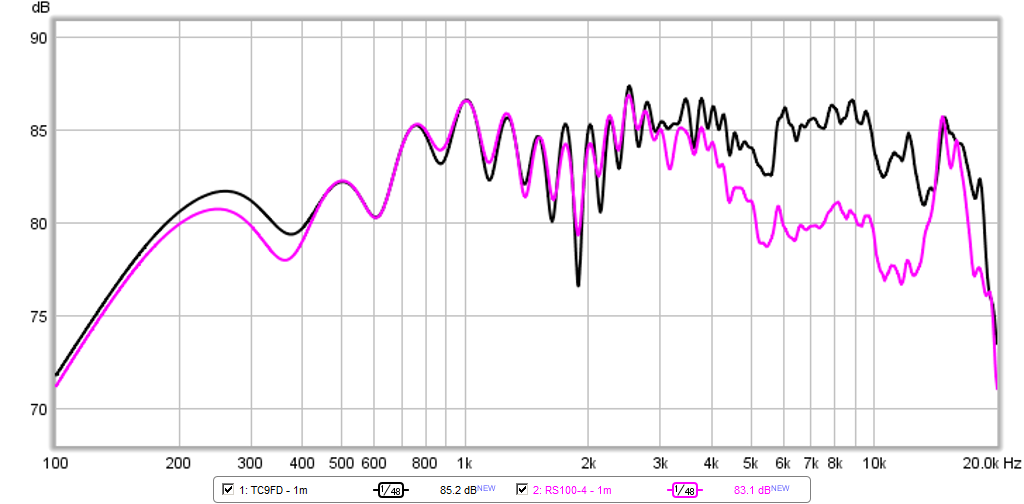
TC9FD vs RS100P-4:
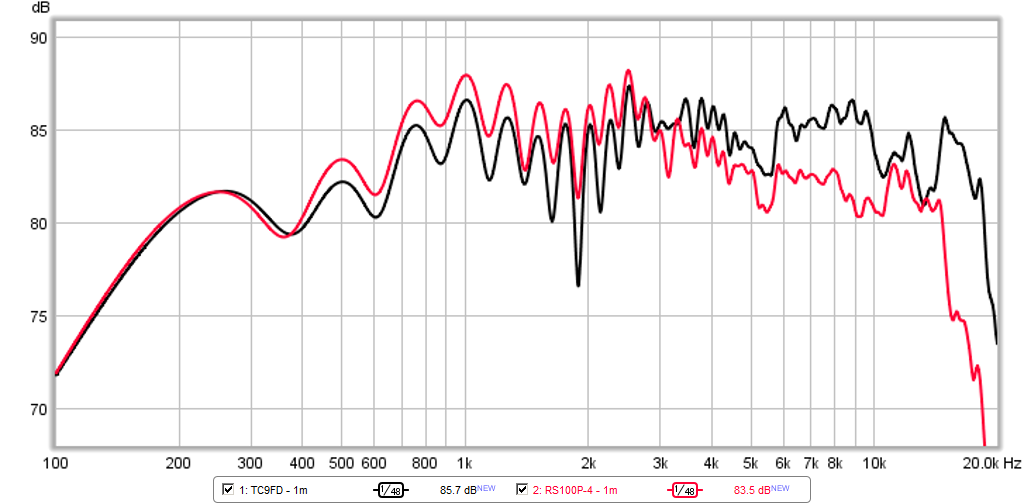
TC9FD vs CHN-70:
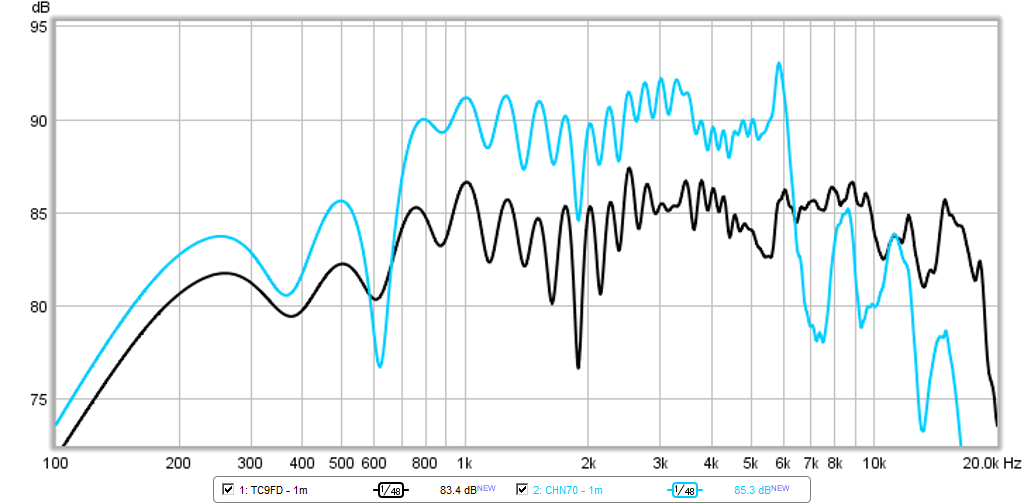
TC9FD vs PS95-8:

Per members' requests for: 5dB increments, 1 meter distance, 2.83v drive level, 5 ms gating to remove low frequency room effects (don't look below 200Hz), 1/48th octave smoothing, etc. Distance measured with a ruler from driver bezel to mic at driver centerline axis. The manufacturer's rated SPL sensitivity matches pretty closely what I measure, an indication that my calibration is OK on absolute SPL scale. I am new at using gating in REW, I set to 5ms, which means 100Hz resolution, and nothing below 200Hz is any good. Let me know if this is an incorrect setting to use for displaying the data to remove room effects.
TC9FD vs 3FE22-4:

TC9FD vs 3FE22-16:

TC9FD vs RS100-4:

TC9FD vs RS100P-4:

TC9FD vs CHN-70:

TC9FD vs PS95-8:

Attachments
-
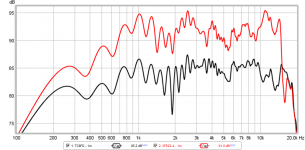 tc9fd-vs-3fe22-4-1m-highres-5ms-gate.png105.5 KB · Views: 2,859
tc9fd-vs-3fe22-4-1m-highres-5ms-gate.png105.5 KB · Views: 2,859 -
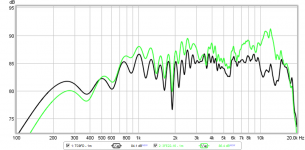 tc9fd-vs-3fe22-16-1m-highres-5ms-gate.png103.9 KB · Views: 2,847
tc9fd-vs-3fe22-16-1m-highres-5ms-gate.png103.9 KB · Views: 2,847 -
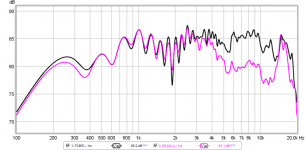 tc9fd-vs-rs100-4-1m-highres-5ms-gate.png91.2 KB · Views: 2,833
tc9fd-vs-rs100-4-1m-highres-5ms-gate.png91.2 KB · Views: 2,833 -
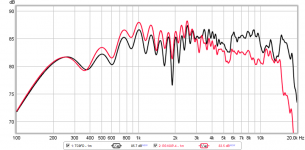 tc9fd-vs-rs100p-4-1m-highres-5ms-gate.png101.8 KB · Views: 2,862
tc9fd-vs-rs100p-4-1m-highres-5ms-gate.png101.8 KB · Views: 2,862 -
 tc9fd-vs-chn70-1m-highres-5ms-gate.png113.4 KB · Views: 3,009
tc9fd-vs-chn70-1m-highres-5ms-gate.png113.4 KB · Views: 3,009 -
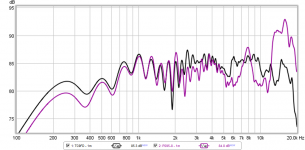 tc9fd-vs-ps95-8-1m-highres-5ms-gate.png112.5 KB · Views: 2,745
tc9fd-vs-ps95-8-1m-highres-5ms-gate.png112.5 KB · Views: 2,745
Last edited:
- Status
- Not open for further replies.
- Home
- Loudspeakers
- Full Range
- An Objective Comparison of 3in - 4in Class Full Range Drivers